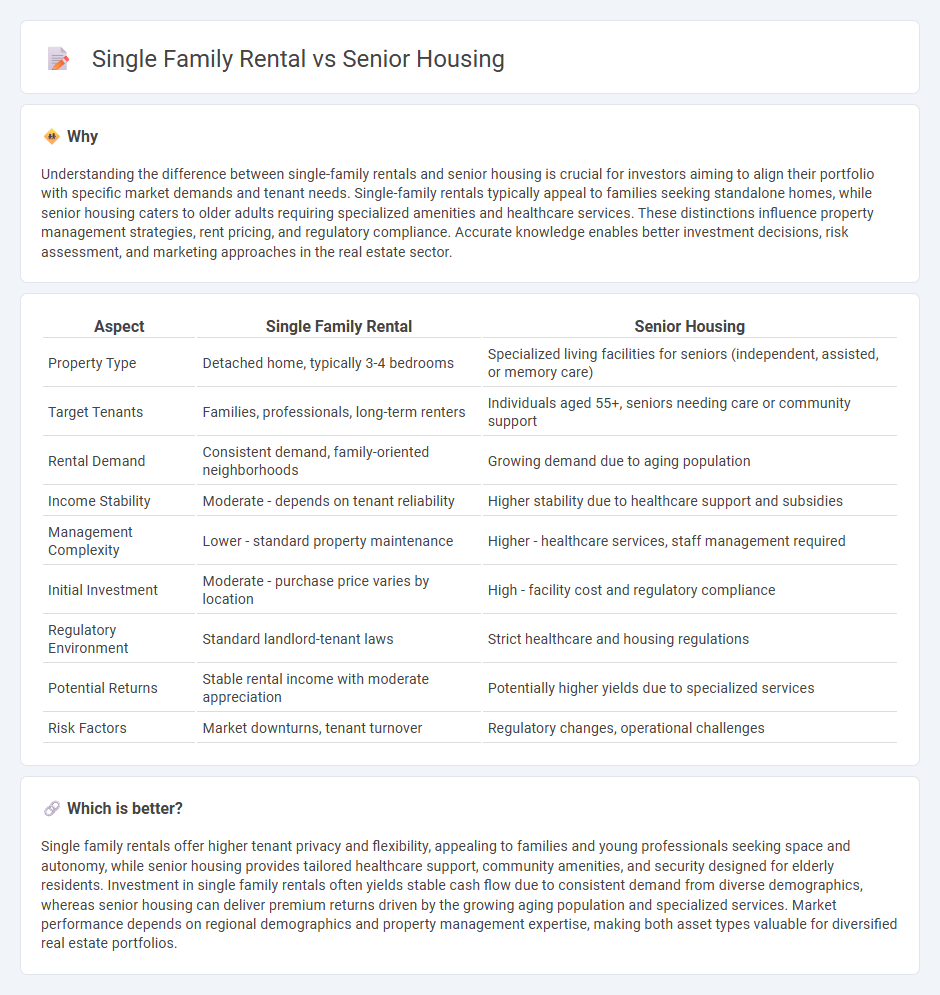
Single family rental properties offer privacy, spacious living, and appeal to families and long-term tenants seeking homeownership alternatives. Senior housing specializes in accessible design, community amenities, and healthcare services tailored to older adults' needs, often including assisted living and memory care options. Explore more about choosing the ideal real estate investment based on demographic trends and lifestyle requirements.
Why it is important
Understanding the difference between single-family rentals and senior housing is crucial for investors aiming to align their portfolio with specific market demands and tenant needs. Single-family rentals typically appeal to families seeking standalone homes, while senior housing caters to older adults requiring specialized amenities and healthcare services. These distinctions influence property management strategies, rent pricing, and regulatory compliance. Accurate knowledge enables better investment decisions, risk assessment, and marketing approaches in the real estate sector.
Comparison Table
| Aspect | Single Family Rental | Senior Housing |
|---|---|---|
| Property Type | Detached home, typically 3-4 bedrooms | Specialized living facilities for seniors (independent, assisted, or memory care) |
| Target Tenants | Families, professionals, long-term renters | Individuals aged 55+, seniors needing care or community support |
| Rental Demand | Consistent demand, family-oriented neighborhoods | Growing demand due to aging population |
| Income Stability | Moderate - depends on tenant reliability | Higher stability due to healthcare support and subsidies |
| Management Complexity | Lower - standard property maintenance | Higher - healthcare services, staff management required |
| Initial Investment | Moderate - purchase price varies by location | High - facility cost and regulatory compliance |
| Regulatory Environment | Standard landlord-tenant laws | Strict healthcare and housing regulations |
| Potential Returns | Stable rental income with moderate appreciation | Potentially higher yields due to specialized services |
| Risk Factors | Market downturns, tenant turnover | Regulatory changes, operational challenges |
Which is better?
Single family rentals offer higher tenant privacy and flexibility, appealing to families and young professionals seeking space and autonomy, while senior housing provides tailored healthcare support, community amenities, and security designed for elderly residents. Investment in single family rentals often yields stable cash flow due to consistent demand from diverse demographics, whereas senior housing can deliver premium returns driven by the growing aging population and specialized services. Market performance depends on regional demographics and property management expertise, making both asset types valuable for diversified real estate portfolios.
Connection
Single family rentals and senior housing intersect in addressing the growing demand for age-appropriate, independent living solutions within residential real estate markets. Both sectors benefit from demographic trends showing an increasing senior population seeking affordable, single-family home rentals that offer privacy and community amenities. Investors targeting these markets prioritize locations with accessible healthcare facilities and supportive infrastructure to maximize occupancy and long-term property value.
Key Terms
Assisted Living
Assisted living in senior housing provides specialized care tailored to elderly residents, including medical support, daily living assistance, and social activities, enhancing quality of life beyond standard housing options. Single family rentals typically lack these dedicated services, offering more autonomy but less comprehensive support for seniors needing assistance. Explore the benefits of assisted living communities to understand their impact on senior wellbeing and housing choices.
Lease Agreement
Lease agreements for senior housing typically emphasize flexible terms, accessibility accommodations, and community services, ensuring compliance with regulations tailored to older adults. Single family rental leases focus on tenant responsibilities, maintenance clauses, and property use restrictions, often standardized for residential tenancy laws. Explore detailed comparisons to understand the legal nuances and benefits of each lease type.
Independent Living
Independent living communities offer senior housing options designed to promote autonomy, social engagement, and accessibility for older adults, differentiating them from single-family rentals which primarily serve general residential needs. These senior housing options often include tailored amenities such as meal services, transportation, and wellness programs, emphasizing convenience and safety for aging residents. Discover more about how independent living compares to traditional rental options in supporting seniors' lifestyle and care requirements.
Source and External Links
Senior Housing | City of Dearborn - Provides housing options for moderate-income seniors aged 55 and older in Dearborn, Michigan.
Warren Senior Housing - Offers affordable, independent senior housing for individuals aged 60 and older in Warren, Michigan.
Senior Housing Preservation Detroit - A coalition advocating for the preservation of affordable senior living in Detroit.
 dowidth.com
dowidth.com